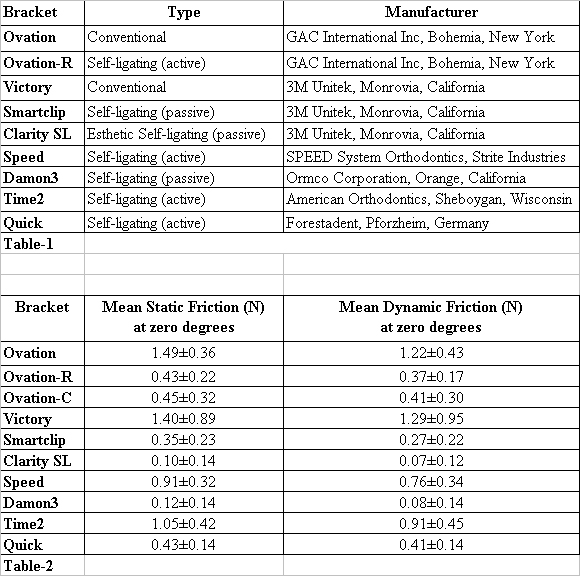ABSTRACT: 2388
Evaluation of Static and Dynamic Friction of Different Self-Ligating Brackets
| L. PIEDADE1, T. BONSTEIN1, M. LEKIC1, and W.A. WILTSHIRE2, 1University of Manitoba, Winnipeg, Canada, 2University of Manitoba, Winnipeg, Manitoba, Canada | |
Objectives: To determine the differences in static and dynamic friction resistance of 8 self-ligating brackets (active and passive) and 2 conventional bracket systems when using rectangular stainless steel wires. Methods: Ten different maxillary 0.022 premolar brackets (See Table-1) were tested with 0.019 x 0.025 inch rectangular stainless steel archwires (American Orthodontics, Sheboygan, Wisconsin) under dry conditions (n=10). The archwire and bracket were paired such that only one archwire was drawn through its paired bracket using a Zwick mechanical testing machine. Each bracket/wire pair for all samples was tested at 0° of angulation. The magnitude of the static and dynamic frictional forces for each sample was then measured. The average frictional forces for all the samples were compared with regards to friction resistance. Data was analyzed using ANOVA single factor (a=0.05). Results: No statistical significant difference was found between static and dynamic friction (p>0.05) for all bracket systems. A statistically significant difference was found between self-ligating and conventional brackets, as well as, between active and passive self-ligating bracket systems (p<0.05) (See Table-2). Conclusion: Passive self-ligating brackets produce less friction than both active self-ligating and conventional bracket systems. This may improve clinical performance especially when using sliding mechanics during space closure.
| |
| Seq #224 - Orthodontic Tooth Movement and Materials 3:30 PM-4:45 PM, Friday, July 4, 2008 Metro Toronto Convention Centre Exhibit Hall D-E | |
|
Back to the Dental Materials 8: Other Materials - Chemistry, Properties and Performance Program | |
©Copyright 2008 American Association for Dental Research. All Rights Reserved.
